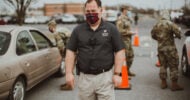![]() Each time I reach the point of recommending radiation treatment for someone with a brain tumor or head and neck cancer, I ask for a higher level of trust from each patient than usual: let us make a mask to keep you safe.
Each time I reach the point of recommending radiation treatment for someone with a brain tumor or head and neck cancer, I ask for a higher level of trust from each patient than usual: let us make a mask to keep you safe.
Radiation therapy is already a leap of faith — who wants invisible rays shooting through them? Fear of unknown radiation side effects and tangential knowledge of whole body exposure risks that don’t apply are common in all my patients. But making a mask requires additional courage and trust. Once your head is supported but bolted to the treatment table, the chance to escape is gone. The therapists may be wonderful, but you’re pinned down and alone in that room. Beam on, the linear accelerator chirping like a Geiger counter.
In the U.S., there are 40,000 people each year with a new primary brain tumor, a similar number with head and neck cancer, and over 100,000 with brain metastases. That’s tens of thousands that require a mask each year. Sometimes people need more than one treatment course and have to go through it again. And again.
From a safety standpoint, the mask is essential. Less movement means more precision and accuracy, which can translate to fewer side effects. In some cases, like stereotactic radiation, immobilization permits me to give radiation doses that couldn’t be done effectively any other way. But that doesn’t mean it’s easy on patients or their loved ones who help encourage them each time before getting on the table.
When you lie down for planning, the therapists take warm, wet plastic from a waterbath and lay it over you. Gently smoothed to fit well, the mask hardens as it cools. It’s a mold that provides a durable, reproducible position for treatment. But that mask also becomes an enduring, tangible relic of cancer treatment. A plastic sculpture capturing a snapshot of the cancer experience, and the hopes and fears that go with it.
Some don’t want to see it again. Some want to take it home to destroy, while others may want to hang it on the wall, a badge of courage. Another fascinating approach has been using that mask for self-expression, creatively displaying that courage for others. Sometimes sharing can make it easier, a chance to celebrate life after treatment.
Claustrophobia is fairly common. I can prescribe medication to make it easier, but I suspect some of the anxiety is the fear involved in making such a leap of faith. It’s one thing when I already know the patient, but often that’s not the case.
We can do a better job of preparing patients, making that leap of faith a little less daunting. There are educational materials available, and we can talk about it. But I think better yet would be to see the process, to make it less of an unknown.
So I’m going to video the process, with myself as the patient. The effort on our part may make it easier for patients to have faith in us. So I ask you, patients, advocates and doctors: what do you want to see?
Matthew Katz is a radiation oncologist. He blogs for ASCO Connection and can be found on Twitter @subatomicdoc and Google+.












![Preventing physician burnout before it begins in med school [PODCAST]](https://kevinmd.com/wp-content/uploads/The-Podcast-by-KevinMD-WideScreen-3000-px-4-190x100.jpg)



![Why high-quality embryos sometimes fail to implant [PODCAST]](https://kevinmd.com/wp-content/uploads/Design-3-190x100.jpg)
